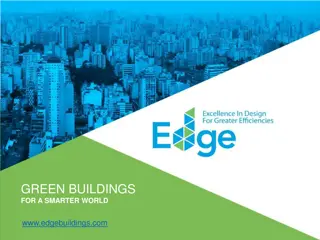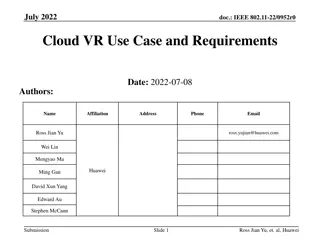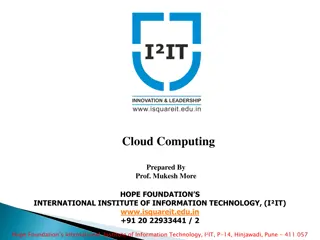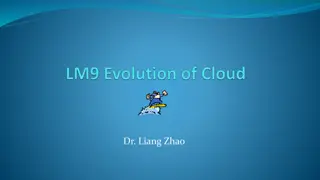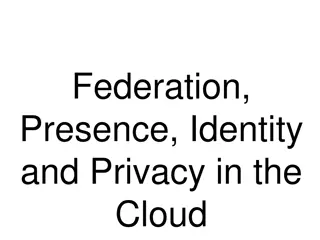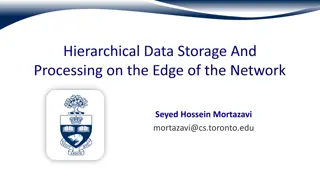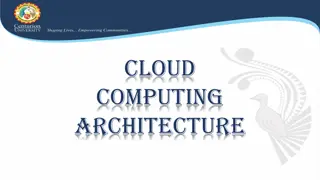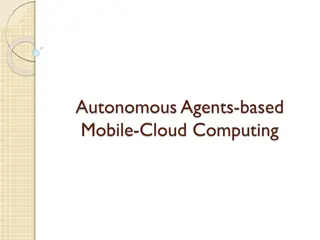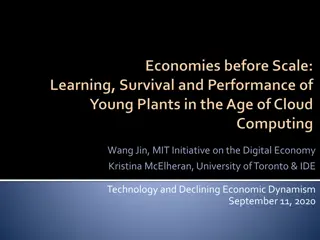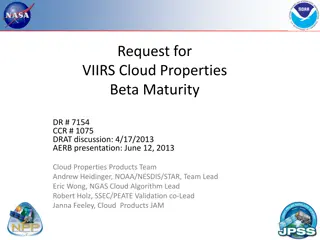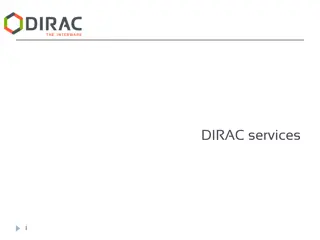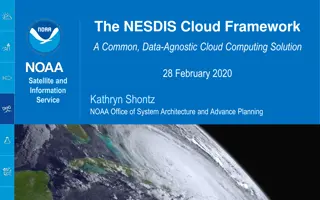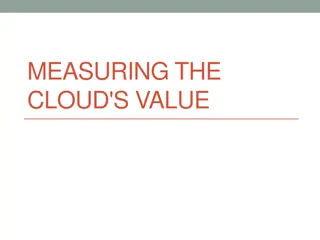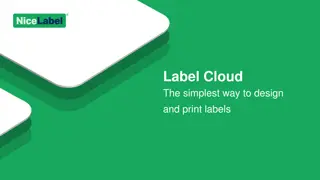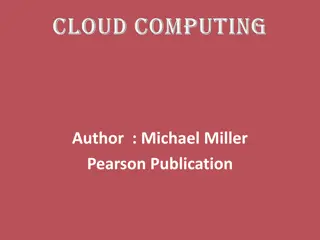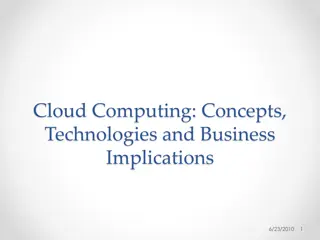Understanding Cloud Computing, Edge Computing, and Their Applications
Cloud computing entails centralized processing of data on powerful servers, offering scalable resources over the internet. Edge computing brings processing closer to data generation points, reducing latency and enhancing security. Both paradigms cater to different needs such as IoT, autonomous vehicles, and avionics, with cloud computing suitable for centralized operations and edge computing for real-time, local processing.
Download Presentation

Please find below an Image/Link to download the presentation.
The content on the website is provided AS IS for your information and personal use only. It may not be sold, licensed, or shared on other websites without obtaining consent from the author. Download presentation by click this link. If you encounter any issues during the download, it is possible that the publisher has removed the file from their server.
E N D
Presentation Transcript
Cloud computing In Cloud Computing, collected data is streamed to a central server and data is processed on a powerful central server which is usually far away from the data source. Cloud Computing or simply the Cloud ,is a means to host and deliver on-demand computing resources or services via a public infrastructure (e.g. the Internet). The services vary from elementary services like computation and data storage to more advanced services like machine learning. cloud computing provides highly scalable and almost unlimited storage for business solutions.
provides really high processing power when compared to the Fog/Edge computing. High latency, possible downtime, and security could be chronic issues in cloud computing for IoT.
Edge computing Edge Computing brings processing power closer to where the data is being generated. It does not send generated data to a central location directly. The data can be processed on the device where the sensors are connected or a gateway device in close proximity. Fog/Edge Computing and storage systems are located closer to the edge to eliminate latency. Fog/Edge computing can be integrated with cloud computing if needed. They can work as an extension of cloud computing
The main goal here is to reduce the amount of sent data to reduce latency between the nodes to improve the overall system response time. Data is not transferred to a central location, it is considered more secure. Edge computing is used to process time-sensitive data, while cloud computing is used to process data that is not time-driven. Autonomous vehicles, like self-driving cars, need instant decision to avoid collusion or detecting pedestrians .so the sensor or camera data needs to be analyzed on the vehicle (edge) to eliminate the latency .
In avionics, many sensors are embedded on the aircrafts such as pressure,speed, engine, position, load, fuel, position, torque, steering, engine, gravity, etc. Considering commercial airlines to haul passengers we can say that data needs to be collected from airplane sensors and needs to converted from analog to digital to inform the pilots for decisions. This example shows how the Fog/Edge paradigm is used in commercial airlines since the data is processed on aircraft. However, considering Unmanned Aerial Vehicles (UAV) could be a good fit in cloud computing since UAV is operated from a central location based on the streamed sensor data from UAV sensors. Another example of cloud computing could be from space crafts and orbital satellites. Due to the hardware constraints, collected data needs to be streamed to earth for further processing and analysis.
Even though there are well known Cloud Computing advantages as hardware independency, cybersecurity, scalability, harmonization, low maintenance, higher implementation times with less risk. However, it also has drawbacks. Some disadvantages go against the industrial sector s fundamental requirements: availability, response time, or privacy.
A full grid contains the generation, transmission and the distribution, where we emphasize the electricity distribution network with the coupled information network on top. This part of the grid contains the infrastructure for distributing electricity to customers, from the transmission grid out to the substations and finally the customers with smart meters to measure quality of the delivered electricity as well as to handle billing. The smart meters can be seen as a type of IoT devices, which communicate using ZigBee, BLE, LoRa, NB-IoT, etc. All together, they build up the Advanced Metering Infrastructure (AMI), which is the heart of a smart grid system.
1. Smart meters: Instant usage data from the smart meters are collected by the sensors and then sent to the utility head- ends via data concentrators, for further analysis and/or storage to be used at billing, statistics, etc. Think of IoT layer of the Fig. 2. Data concentrator: Data from many (hundreds-thousands) smart meters are collected at the data concentrators and relayed to the AMI head-end. Think of Fog layer of the Fig. 3. AMI head-end: A broad spectrum of the data is stored and processed at the AMI head-end (the utility side), such as the consumer short/long term electricity usage data. Think of Cloud layer of the Fig.
electricity usage data of the consumers follow the path of 1-2-3 (upstream); whereas commands (such as pushing software patches) from the control center follow the reverse path of 3-2-1 (downstream). Some data generated at the smart meter is used for billing. As such, it needs to be correct, can be aggregated and only available to the AMI head-end at regular intervals and not in real time. Other data generated at the smart meter offers the possibility to improve the overall electricity quality if it can be shared instantaneous with at least the data concentrator (and the corresponding sub station for the electricity flow).



